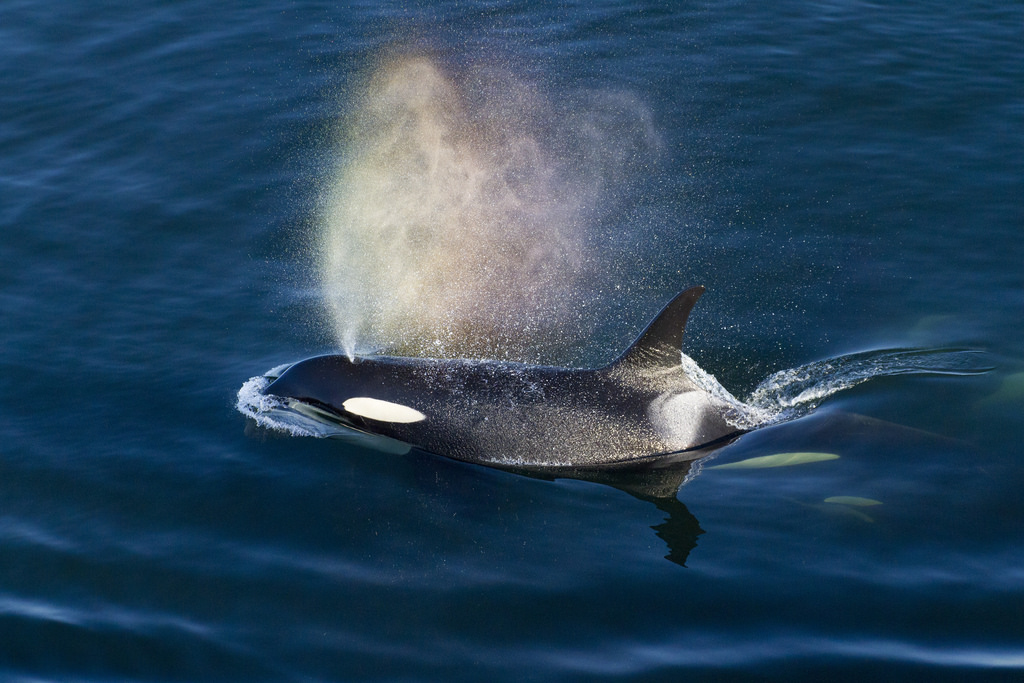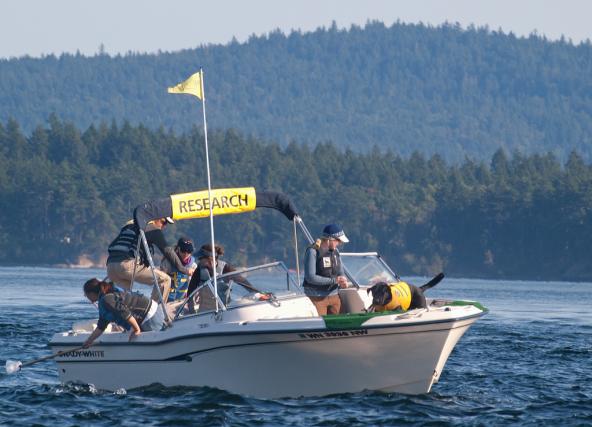
Recent images of a mother orca appearing to grieve for her dead calf have brought worldwide attention to the plight of Puget Sound’s endangered Southern Resident orcas. As orca numbers decline, we look at how the effects of toxic chemicals on the whales are magnified even as the residents slowly starve from a general lack of Chinook salmon, their chief source of food.

There’s a classic Harry Hershfield cartoon that shows an elderly lady complaining about a restaurant’s food: “It’s terrible!” she says. “Every mouthful is positively poison! And they give you such small portions!”
It’s a funny commentary on the human condition, but that 1927 cartoon, stripped of its irony, is now a tragically literal representation of the situation facing our endangered Southern Resident Killer Whales.
The whales evolved to take advantage of the Salish Sea’s and Eastern Pacific Coast’s salmon cycle. With all kinds of fish and other prey to choose from, over time this orca ecotype zeroed in on the most plentiful species of large, fatty fish around — an energy-rich, super-sized silver sausage that gathered in huge, predictable, easy to find schools: The Chinook salmon.
King salmon populations themselves evolved to stagger spawning runs throughout the year as their own adaptation to ensure survival, and the orcas of J, K and L Pods learned to time their movements to catch up with the Chinook as they returned to breed in various natal streams from California to British Columbia.
Southern Residents could fatten up on the massive schools of kings at the mouth of the Columbia, and then move north into the Salish Sea, which back in the days before we disrupted the ecosystem was like an overstocked farm pond teeming with Chinook pouring in from the open Pacific to hundreds of spawning streams, especially those connected to the Fraser River.
The Chinook of the pre-industrial Columbia and Fraser watersheds were a reliable, plentiful, healthful, year-round moveable feast for the fish-eating killer whales (and, at the same time, generously fed large populations of seals and sea lions as well as the first humans to settle the region).
A fraction of the population
Today, the Chinook are none of those things. Many wild runs have gone extinct while others are endangered, down to fractions of historic population size. Even the individual fish are smaller, on average, so that the orca must expend more energy to catch the same number of calories.
Hershfield’s cartoon critic calling the restaurant’s food “poison” was hyperbole. For today’s Southern Residents, however, the Chinook served up in their home waters are also, indeed, toxic.
The fish the orcas evolved to depend on for at least 80% of their diet are so contaminated with our persistent organic pollutants (POPs) like PCBs, PBDEs and DDTs, and so liberally seasoned with lead and mercury, that the Washington Department of Health guidelines suggest adult humans eat no more than eight ounces per week of Chinook even when they’re caught in what are considered the cleanest waters on the U.S.-side of the Salish Sea.
For “blackmouth” Chinook that live their whole lives inside the Salish Sea instead of feeding out in the open Pacific for years like other kings, the health guidelines limit adults to half that amount.
Adult orcas eat more than 300 pounds of contaminated fish every day just to stay alive.
As for adult orcas? They eat more than 300 pounds of contaminated fish every day just to stay alive, with a pregnant female needing as much as an extra 100 pounds when she’s feeding for two. And orcas don’t have the luxury of trimming out some of the most toxic parts of the fish like we do.
“These are urbanized animals,” says Dr. Jessica Lundin, speaking of the toxicants found in Southern Resident Killer Whales. Lundin was part of a University of Washington team that studied toxic chemicals in SRKWs using methods pioneered by Dr. Sam Wasser, director of UW’s Center for Conservation Biology and the founder of Conservation Canines. Conservation Canines is a unique program that sends specially trained dogs around the world to find other animals’ scat to measure human impacts on wildlife and help save a variety of endangered species, from elephants to right whales.
During their monitoring of the Southern Residents, the team's lead dog Tucker enabled the group to collect 266 samples from 54 different whales. “And every single sample was collected non-invasively,” says Lundin. “We’re really proud of that.”
Previously, scientists got most of their extensive health information on Southern Resident Killer Whales through dart biopsies on live animals or necropsies of dead ones. Wasser’s lab, however, has developed such sophisticated testing methods that each killer whale dropping sniffed out by Tucker and scooped from the water is dripping with data.

“The tests we can now do on fecal samples,” says Wasser, “are similar to what your doctor does during your annual physical — it’s like running a health panel from a blood test.”
By cross-referencing their samples with the 42 years of population data collected by the Center for Whale Research’s Orca Survey, the scientists aren’t just observing general trends in the SRKWs, they’re getting timely health reports on individual whales whose entire family connections and histories are well documented.
“This kind of detailed contextual information is unprecedented for a study of wild killer whales,” says Lundin.
Stress from lack of food
As covered elsewhere, [read our previous coverage in Salish Sea Currents: Killer whale miscarriages linked to low food supply] the team’s measurements of the Southern Residents’ glucocortoid levels and thyroid and other hormones shows disturbing evidence of stress from lack of food and a high number of miscarriages (an especially bad data point in a population of just 75 animals — a 30-year low — that hasn’t added a live calf in three years).
They also measured the amount of toxic chemicals, including POPs, that flowed through the whales’ systems.
“Though all three pods are ‘Southern Residents’,” says Ken Balcomb, founder of the Center for Whale Research, “they have somewhat different feeding strategies.” L pod, he explains, spends more time along the coast as far south as California, picking up especially high amounts of agricultural chemicals, while J pod, which historically spends the most time inside the Salish Sea, is burdened with the most industrial pollutants. “It’s a sad testimony to the whale’s situation,” he says, “that toxicologists can distinguish the pods just by their contaminant signatures.” [For more information about resident orca contaminant signatures, please see page 18 of the 2016 Salish Sea Toxics Monitoring Review: A Selection of Research.]
And here’s where the cartoon irony meeting orca reality reaches an unhappy absurdity.

“These POPs are lipophilic, stored in the fat,” says Lundin. “And that’s where mammals keep their emergency energy reserves.”
Under no condition is it good for orcas (or us) to have POPs stored in our adipose tissue since that’s time-released trouble with potential bad effects over the years. But when an animal doesn’t have enough food available to eat and needs to draw on its fat reserves just to keep going, all those harmful chemicals stored in its fat flood into the bloodstream at much higher levels.
So even though biomagnification of toxics through the food web into salmon means that the SRKW’s diet causes them to already be among the most contaminated animals on the planet, the orcas of J, K and L pod desperately need bigger portions of those “poison” meals.
To test this counterintuitive “eat more toxic fish to stay healthier” theory, the researchers looked at the number of fish returning to the Fraser River.
Lundin reports, “We found that, indeed, when Chinook abundance was lowest, the level of toxics in the Southern Resident Killer Whales was highest.”
Previous studies have related high orca mortality and decreased calf production to low prey availability. This new data suggests that not only are the whales calorie-starved, but that the hungrier they get, the more toxics they have circulating and threatening their immune, endocrine and reproductive systems.
“The compounding effects of these stresses — lack of prey and increased metabolization of toxics — happening concurrently,” says Lundin, “may be further perpetuating the effects of increased mortality and decreased calf production.”
More evidence is in the observation of Transient (Biggs) killer whales, which prey on marine mammals that accumulate much higher levels of contaminants than salmon. Even though these whales have more toxics in their fat than SRKWs, their populations are doing fine and having plenty of calves because they have plenty to eat.
For Puget Sound's resident orcas, the problem of high calf mortality has come into dramatic focus over the last two weeks. News outlets from around the world have been showing images of a mother orca, J35, carrying her calf that died shortly after it was born on July 24. J35 carried the dead calf for at least 17 days and 1000 miles before releasing it. Meanwhile, another young J-pod orca, J50, is in very bad shape, thin and potentially suffering from infections. NOAA scientists have been undertaking desperate measures to attempt to save the three-year-old female including possibly administering antibiotics and attempting to feed her live Chinook.
These events have contributed to stepped up efforts from the state's orca task force which met last week to discuss solutions to the crisis. In the end, scientists say, it may all come down to one thing: For Puget Sound's rapidly disappearing resident orca population, food is fate.

